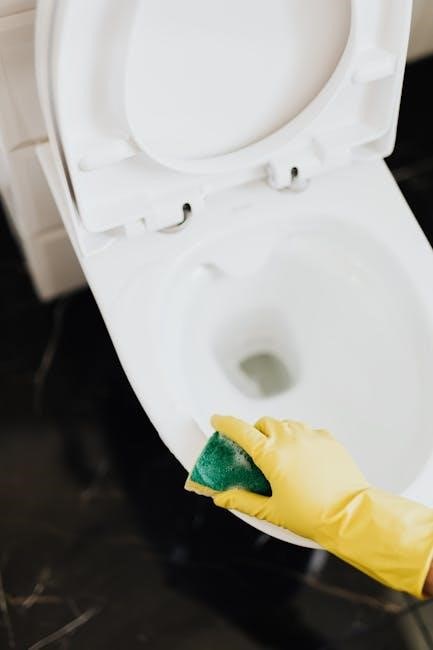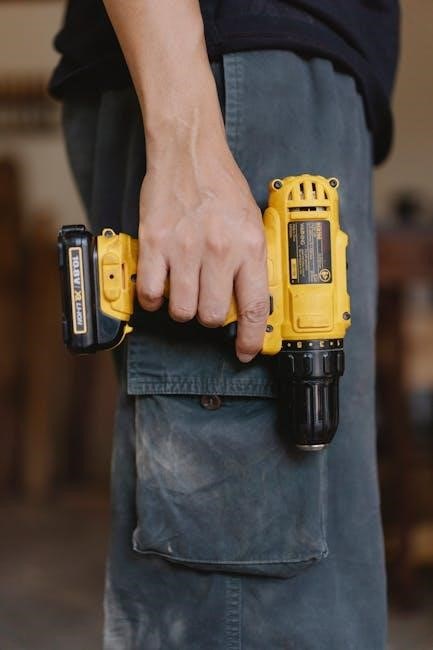Manual lensometry is a precise method of measuring optical properties of lenses using a lensometer, ensuring accurate verification of prescriptions and optical alignment in eyewear.
What is Manual Lensometry?
Manual lensometry is a technique used to measure the optical properties of lenses, such as spherical power, cylindrical power, axis, and prism. It involves the use of a lensometer, an ophthalmic instrument, to accurately determine the prescription of eyeglasses, contact lenses, or other optical devices. This method requires precise alignment and focusing of the eyepiece to ensure reliable results. Manual lensometry is essential in optometry for verifying the accuracy of lens prescriptions and ensuring proper alignment for optimal vision correction. It is particularly useful for measuring both single-vision and multifocal lenses, including bifocal and progressive lenses, by carefully adjusting the lensometer’s settings and following specific measurement techniques.
Importance of Manual Lensometry in Optometry
Manual lensometry plays a crucial role in optometry by ensuring accurate measurement and verification of lens prescriptions. It allows optometrists to confirm that eyewear meets specified optical requirements, which is vital for correcting vision effectively. This technique is essential for verifying both single-vision and multifocal lenses, including bifocal and progressive designs. By accurately measuring spherical power, cylindrical power, axis, and prism, manual lensometry helps in detecting any discrepancies in the lens fabrication process. This ensures that patients receive eyewear tailored to their specific needs, improving visual clarity and comfort. Additionally, manual lensometry is a cost-effective method compared to automated systems, making it a valuable tool for optometric practices worldwide.

Setting Up and Preparing for Manual Lensometry
Position the lensometer on a stable surface, adjust the stage height, and ensure the eyepiece is focused. Prepare the instrument for calibration and measurement accuracy.
Proper Setup of the Lensometer
Begin by positioning the lensometer on a stable, flat surface to ensure accuracy. Adjust the stage height to align the instrument with your eye level, minimizing strain during use. Next, secure the lensometer to the surface if possible, to prevent movement. Place the eyepiece at a comfortable viewing height and focus it using a white object or your thumb, as described in the neutralization process. Ensure the lens stop is correctly positioned to hold the lens firmly in place. Finally, check that all stage locks are tightened to maintain the lens’s alignment. Proper setup ensures precise measurements and optimal performance of the instrument.
Neutralizing the Eyepiece
Neutralizing the eyepiece is a critical step to ensure accurate measurements. Begin by covering the lens stop with a white object or your thumb to create a neutral reference. Adjust the eyepiece focus until the reticle appears sharp and clear. This step eliminates any personal refractive errors, ensuring the eyepiece aligns with your vision. Once the reticle is sharp, the eyepiece is neutralized, providing a baseline for precise lens measurements. Proper neutralization is essential for obtaining accurate spherical, cylindrical, and prism power readings. This process should be performed before each use to maintain consistency and reliability in your lensometry results. Neutralizing the eyepiece is a fundamental skill in manual lensometry, ensuring accurate and reproducible measurements every time.
Calibrating the Lensometer
Calibrating the lensometer ensures precise measurements by aligning the instrument to a known standard. Begin by turning on the lensometer and allowing it to warm up. Place a calibration lens with a known spherical power on the lens stop. Adjust the focus knob until the reticle aligns with the lens’s optical center. Fine-tune the calibration knob to achieve a zero reading, ensuring accuracy for spherical, cylindrical, and prism measurements. Regular calibration is essential to maintain reliability and prevent measurement errors. Always refer to the manufacturer’s instructions for specific calibration procedures, as improper calibration can lead to inaccurate results. Proper calibration ensures the lensometer performs optimally, providing consistent and reliable measurements for various lens types.
Focusing the Eyepiece and Measuring Techniques
Focusing the eyepiece ensures clear visibility of the reticle, while precise measuring techniques involve proper lens alignment and accurate adjustment of the focus knob.
Focusing the Eyepiece for Accurate Measurements
Focusing the eyepiece is critical for clear visibility of the reticle and precise measurements. Begin by turning on the lensometer and adjusting the eyepiece focus using a white surface or thumb to neutralize it. Proper alignment ensures the reticle appears sharp and centered. Once focused, place the lens on the stage, aligning it with the lens stop. Fine-tune the focus knob to achieve optimal clarity. Accurate focus prevents measurement errors, ensuring reliable spherical, cylindrical, and prism power readings. Improper focus can lead to inaccurate results, emphasizing the need for careful adjustment. Regular practice enhances proficiency in this essential step of manual lensometry.
Measuring Spherical Power
Measuring spherical power involves aligning the lens correctly on the lensometer stage and adjusting the focus and spherical knobs. Position the lens with the back surface against the lens stop. Use the focus knob to center the reticle, then adjust the spherical knob until the horizontal and vertical crosshairs align with the target. The spherical power is read directly from the scale. Ensure the lens is properly centered and the reticle is sharp for accurate results. Incorrect alignment or focus can lead to errors. This step is fundamental for determining the lens’s refractive power, whether positive or negative, ensuring precise prescription verification in manual lensometry.
Measuring Cylindrical Power and Axis
Measuring cylindrical power and axis involves determining the astigmatism correction in a lens. After focusing the eyepiece, position the lens on the stage with the back surface against the lens stop. Rotate the axis knob to align the crosshair with the lens’s cylindrical axis marker. Adjust the cylinder knob until the horizontal and vertical crosshairs match, indicating the correct axis and power. The axis is read from the protractor scale, while the cylindrical power is shown on the cylinder knob. Proper alignment and rotation are critical to avoid measurement errors. Accurate determination of cylindrical power and axis ensures correct astigmatism correction, essential for precise lens verification in manual lensometry.
Measuring Prism Power
Measuring prism power involves assessing the horizontal deviation correction in a lens. Focus the eyepiece first, then position the lens on the stage with the back surface against the lens stop. Use the prism knob to adjust the lensometer until the prism indicator aligns with the target. The prism power is read from the scale, and the direction (inward or outward) is noted. Ensure the lens is centered to avoid measurement errors. Accurate prism measurement is essential for correcting eye alignment issues, such as esophoria or exophoria. Proper alignment and adjustment are critical to ensure the lens meets the prescribed prism power, providing the necessary visual correction for the wearer.


Instructions for Specific Lens Types
Manual lensometry techniques vary for single vision, bifocal, multifocal, and progressive lenses, requiring tailored approaches to accurately measure spherical, cylindrical, and prism powers for each type.
Measuring Single Vision Lenses
Measuring single vision lenses involves placing the lens on the lensometer stage, ensuring proper alignment with the crosshairs. Focus the eyepiece to clearly see the reticle, then position the lens so the target is centered. Measure the spherical power by adjusting the diopter wheel until the horizontal lines align. For cylindrical power and axis, rotate the cylinder axis knob to align the vertical lines, then fine-tune the cylinder power. Record the measurements, ensuring accuracy by verifying proper lens alignment and focus. Always follow the lensometer’s specific instructions for single vision lenses to achieve precise results.
Measuring Bifocal and Multifocal Lenses
Measuring bifocal and multifocal lenses requires careful alignment and focus. For bifocal lenses, position the lens so the segment line is visible and aligned with the crosshairs. Measure the distance portion first by focusing on the main lens area, then the near portion by targeting the segment. For multifocal lenses, such as progressives, measure the distance, intermediate, and near zones separately. Use the lensometer’s reticle to ensure accurate alignment and focus. Adjust the stage height and rotation as needed to access different zones. Record each measurement carefully, ensuring clarity and precision. Always refer to the lensometer’s guide for specific instructions on handling bifocal and multifocal lenses.
Measuring Progressive Lenses
Measuring progressive lenses involves focusing on specific zones due to their gradual power transition. Start by aligning the lensometer’s crosshairs with the distance portion of the lens. Measure the distance power first, ensuring the lens is centered and properly aligned. Next, locate the intermediate and near zones, typically marked by the manufacturer, and measure their powers separately. Use the lensometer’s reticle to guide alignment and focus carefully, as progressive lenses lack visible segment lines. Record each measurement accurately, paying attention to the smooth power transition between zones. Always refer to the lensometer’s user guide for detailed instructions, as the process may vary depending on the lens design and complexity.

Troubleshooting Common Errors
Common errors include misalignment, miscalibration, and incorrect focus. Ensure proper setup, neutralization, and calibration. Consult the user guide for troubleshooting steps to achieve accurate measurements.
Identifying and Correcting Measurement Errors
Measurement errors in manual lensometry often arise from misalignment, improper focusing, or miscalibration. These errors can lead to inaccurate spherical, cylindrical, or prism power readings. To identify issues, look for blurry reticles, inconsistent measurements, or unusual readings. Correcting errors involves recalibrating the lensometer, ensuring proper eyepiece focus, and verifying lens alignment. If errors persist, consult the user guide for troubleshooting steps or perform a neutralization check. Regular maintenance and adherence to proper techniques are essential for reliable results. By addressing these factors, optometrists can ensure precise and accurate measurements, maintaining the integrity of the lensometry process.
Best Practices for Maintenance
Regularly clean the lensometer, check calibration, and ensure proper storage to maintain accuracy and extend its lifespan. Follow manufacturer guidelines for optimal performance and reliability.
Regular Maintenance of the Lensometer
Regular maintenance ensures the lensometer operates accurately and lasts longer. Clean the instrument with a soft cloth, avoiding harsh chemicals. Check and recalibrate the device periodically to maintain precision. Store it in a protective case to prevent damage. Lubricate moving parts if recommended by the manufacturer. Inspect for wear and tear, replacing components as needed. Schedule professional servicing annually to address complex issues. Always follow the manufacturer’s guidelines for care and maintenance to uphold the instrument’s performance and reliability. Proper upkeep ensures consistent and accurate measurements, critical for precise lens evaluation and prescription verification in optometric practices.
